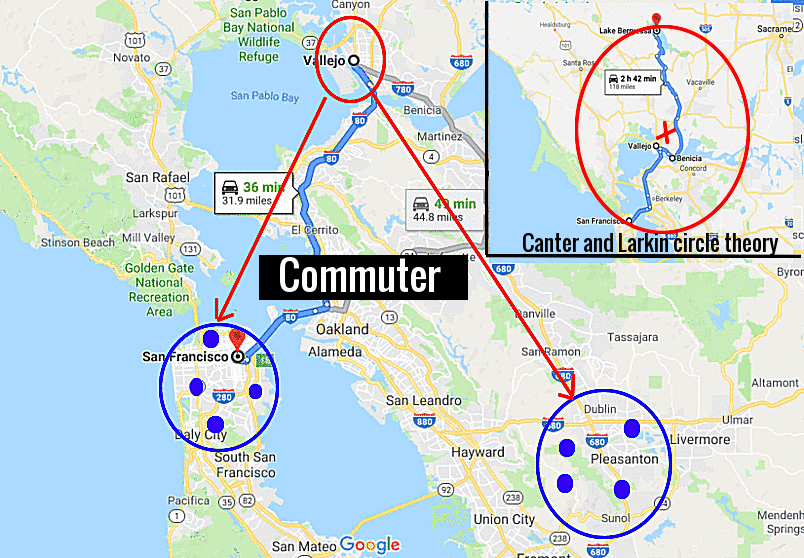A serial killer exhibiting the traits of a marauder will operate using a buffer zone from their residence but radiate from this base when committing their murders, whereas a commuter will operate outside their normal activity spaces, thereby shifting the focus of the investigation away from the offenders anchor point. A serial killer living in Vallejo and operating as a commuter, would in the examples below, travel to San Francisco or Pleasanton to commit their murders and so shift the focus of the investigation away from their home base or residence. Canter and Larkin (1993) proposed the Circle Theory of Environmental Range that suggested a circle drawn around the two furthest offences from each other, would likely reveal the offender's home base, at or near the circle center (as shown by the Zodiac map on the right of the illustration below). This is just a rough example, as the circle could be shifted slightly to the left. Regardless, the center point falls in the approximate area of Vallejo or American Canyon. The problem arises when we draw a circle around a commuter's known offences, in that it would reveal a home location for the killer completely unrelated to his true residence. Therefore, it is critical that we identify whether the Zodiac Killer was a marauder or commuter.
There have been several studies done that suggest the vast majority of serial killers are marauders, who venture out from their anchor point, with the distance chosen from their residence based upon a buffer zone, the least effort principle, distance decay and a mental map of the area. A serial killer will often commit his earlier crimes closer to home because of uncertainty and inexperience, but venture further afield as their confidence grows. From the perspective of a killer working Monday to Friday, one might expect their Friday crimes to be situated closer to their home location, governed by the least effort principle and time constraints. Whereas their Saturday crimes, free from time constraints and tiredness, would unburden their unwillingness to travel further afield. If the Zodiac Killer lived in Vallejo, then the Canter and Larkin model looks like a good fit. Once the Zodiac Killer had committed his first two attacks close to his residence, the natural inclination on a Saturday would be to shift the emphasis away from the Vallejo and Benicia areas. The third attack at Lake Berryessa swung the focus approximately 42 miles north, while the Presidio Heights murder veered the investigation 35 miles south, into a fourth jurisdiction. It could be argued that the Zodiac Killer was deliberately attempting to redirect investigators away from where he lived.
Canter and Young noted from a geographical standpoint that a commuter's crimes will generally be grouped closer together, whereas a marauder's crimes will be more spread. If the Zodiac Killer was a commuter living in Vallejo, one could expect him to commit multiple attacks at a secondary location such as San Francisco, in an attempt to focus the investigation far from home. Grouping the attacks within San Francisco would achieve this objective, but spreading the attacks would effectively nullify this tactic. A killer living in Vallejo may attempt to spread his attacks in all directions with each subsequent attack, designed in such a fashion to confuse investigators trying to pinpoint the murderer's anchor point, but may in essence have the reverse effect to the one desired. However, there is one important dichotomy to unpick when we consider the Zodiac Killer compared to most serial murderers - and that is the copious communications he mailed primarily from San Francisco.
Canter and Young noted from a geographical standpoint that a commuter's crimes will generally be grouped closer together, whereas a marauder's crimes will be more spread. If the Zodiac Killer was a commuter living in Vallejo, one could expect him to commit multiple attacks at a secondary location such as San Francisco, in an attempt to focus the investigation far from home. Grouping the attacks within San Francisco would achieve this objective, but spreading the attacks would effectively nullify this tactic. A killer living in Vallejo may attempt to spread his attacks in all directions with each subsequent attack, designed in such a fashion to confuse investigators trying to pinpoint the murderer's anchor point, but may in essence have the reverse effect to the one desired. However, there is one important dichotomy to unpick when we consider the Zodiac Killer compared to most serial murderers - and that is the copious communications he mailed primarily from San Francisco.

The Zodiac Killer's attacks spread out as time went by, but apart from his Vallejo Times-Herald communication on July 31st 1969, his focus for letter writing centered squarely on San Francisco. The least effort principle argues that when an offender is presented with two or more options to commit a crime, with equal availability and outcome, they will usually opt for the one that takes the least effort to achieve the same objective. The Zodiac Killer only committed four attacks, but likely mailed in excess of 20 letters. Therefore, is he more likely to go out of his way to deceive investigators by shifting his murders around the map in two or three instances, or mail his letters from an array of different locations to achieve a similar objective? He could have mailed his letters from anywhere, but primarily focused on San Francisco. When you are applying the least effort principle to his letter writing, it is easy to understand why he would choose the path of least resistance. If he had lived in Vallejo and mailed them at various locations on his route to work in San Francisco, then investigators (in his mind) may have been able to piece together his route taken and thereby identify an approximate home location. But by mailing virtually everything in San Francisco it could be interpreted by investigators that he lived in San Francisco - which is something the Zodiac Killer probably realized early on when his communications to the Vallejo Times-Herald went no further.
His attacks took on the appearance of a marauder, while his letter writing took on the appearance of a commuter - which is exactly what he would have been, had he worked in San Francisco and lived in Vallejo. When your letter writing count outweighs your murder sites five to one, it is far easier to use this in order to focus investigators into a belief that you live in San Francisco, when it requires no more effort than traveling to work each day. The final confirmed murder at Presidio Heights could have been a deliberate choice by a killer determined to divert the investigation down a path far from home, but by reverse psychology, may have achieved the complete opposite to the one intended.
The Zodiac Killer showed his ability to be unconstrained by a method of operation or modus operandi, with the 'couple killings' more a result of circumstance than choice. Had a third person been present in either vehicle at Lake Herman Road and Blue Rock Springs Park, does anybody believe that the Zodiac Killer would have turned around and gone home? The same could be said for a single person. This was evident when the Zodiac Killer mailed his trinity of letters on July 31st 1969, stating "I will cruse around and pick of all stray people or coupples that are alone, then move on to kill some more untill I have killed over a dozen people". His other two letters made no mention of couples. The idea that this was a sexually frustrated hater of courting couples is not warranted by the limited number of attacks in the sample size, and the idea that he would have just skulked off home, disappointed that he didn't see any couple's making out, is a hard argument to sell. However, the notion of earlier attacks carrying less risk and distance in respect to a home residence, has statistically been proven in previous studies of serial killers, whether or not it is true in this instance.
His attacks took on the appearance of a marauder, while his letter writing took on the appearance of a commuter - which is exactly what he would have been, had he worked in San Francisco and lived in Vallejo. When your letter writing count outweighs your murder sites five to one, it is far easier to use this in order to focus investigators into a belief that you live in San Francisco, when it requires no more effort than traveling to work each day. The final confirmed murder at Presidio Heights could have been a deliberate choice by a killer determined to divert the investigation down a path far from home, but by reverse psychology, may have achieved the complete opposite to the one intended.
The Zodiac Killer showed his ability to be unconstrained by a method of operation or modus operandi, with the 'couple killings' more a result of circumstance than choice. Had a third person been present in either vehicle at Lake Herman Road and Blue Rock Springs Park, does anybody believe that the Zodiac Killer would have turned around and gone home? The same could be said for a single person. This was evident when the Zodiac Killer mailed his trinity of letters on July 31st 1969, stating "I will cruse around and pick of all stray people or coupples that are alone, then move on to kill some more untill I have killed over a dozen people". His other two letters made no mention of couples. The idea that this was a sexually frustrated hater of courting couples is not warranted by the limited number of attacks in the sample size, and the idea that he would have just skulked off home, disappointed that he didn't see any couple's making out, is a hard argument to sell. However, the notion of earlier attacks carrying less risk and distance in respect to a home residence, has statistically been proven in previous studies of serial killers, whether or not it is true in this instance.
